Peeling is rightfully considered an integral element of complete skin care.
After all, this procedure helps to get rid of small wrinkles in a short time.
Let's figure out what this procedure is, how and how many times retinoic peeling can be done, and whether it is possible to use yellow cleansing when planning a pregnancy.
general information
Retinoic peeling can be called one of the most popular chemical peels due to its high efficiency and low trauma; the results of the procedure are comparable to the effects of expensive injection techniques. Many people are interested in whether it is possible to use retinol at home?
Let's look at the pros and cons of peeling, and what results can be achieved with it.
Retinol cleansing - what is it?
Retinoic peels are sometimes called yellow peels due to their ability to stain the skin. The procedure is aimed at exfoliating dead skin cells.
After peeling, the skin takes on a “renewed” appearance, as young cells appear on the surface, undamaged by the negative effects of the environment.
Retinoic peeling can be classified as superficial-medium peeling; exfoliation affects not only the stratum corneum, but also part of the epidermis and the capillaries that supply it with blood.
The active substance used during the procedure stimulates cells to divide, helping to restore skin density. In addition, retinol counteracts the influence of enzymes that destroy elastin and collagen molecules.
Compound
The very name of the procedure suggests that it is based on the use of retinoic acid, that is, an artificial analogue of vitamin A.
In addition, auxiliary acids are used in peeling:
In the complex, the acids have a pronounced rejuvenating effect:
- exfoliate the skin, stimulating the launch of regenerative processes;
- protect cells from the adverse effects of free radicals;
- restore the density and elasticity of the epidermis.
Advantages and disadvantages
It is the numerous benefits that make yellow peeling with retinoic acid such a popular procedure:
- high efficiency, superior to the achievements of softer peelings;
- painlessness;
- fast recovery period;
- absence of unpleasant complications;
- the ability to perform the procedure in the summer without the risk of skin damage.
The disadvantage is that after exposure to retinol, the skin acquires a yellow tint, which, coupled with severe peeling, does not allow one to lead a normal lifestyle.
In addition, a high concentration of retinol has an ambiguous effect on the human body, so the procedure has many contraindications.
Indications and contraindications for retinoic resurfacing
Yellow peeling is most often used to rejuvenate the face, neck, décolleté and hands. The procedure is recommended for mature ladies, but it is not contraindicated at a young age – with excessive formation of freckles or keratosis.
Good results can be obtained in the following cases:
- facial wrinkles;
- excessive pigmentation;
- photoaging;
- keratosis;
- acne marks or scars;
- blackheads
The procedure is strictly contraindicated for pregnant and lactating women, as well as for those planning a pregnancy in the next year - this is due to the teratogenic effect of retinol on the fetus.
Those who are prone to allergies should also be careful.
Preparation and stages of the procedure
To achieve a noticeable result, a fairly long preparatory period is required - from two to four weeks. First of all, it depends on the skin type you have. For example, the Asian type has increased sensitivity to the drug, and in this case long-term preparation is simply necessary.
A doctor will help you assess the condition of your skin and determine whether it belongs to one type or another during a preliminary examination.
The specialist prescribes home use of creams and masks with low concentrations of vitamin A to soften the skin and prepare it for peeling.
In addition, the doctor must ask what medications you are taking and whether you are planning to conceive a child in the near future.
If it turns out that the patient suffers from herpes, then to prevent rashes it will be necessary to take an antiviral drug even before the procedure itself.
During peeling, the specialist carefully removes makeup from the face and applies a mixture of salicylic and glycolic acid, which help quickly exfoliate dead skin cells. Then retinoic acid is applied - even such a sensitive area as the area around the eyes is covered with the composition.
Further, depending on the concentration of the mixture, the active substance is either washed off after twenty minutes or remains on the face for several hours. After removing the acid, the skin must be moisturized with a product prescribed by a specialist.
Darsonvalization of the face: how to do it and how many procedures are needed for a good result, you can read here.
How many myostimulation procedures are needed and how this technique works for weight loss and eliminating the “orange peel”, read here.
Restoration and care of facial skin after
Before the procedure, be sure to ask your doctor how to care for your face after yellow peeling. For several days after peeling, the epidermis intensively peels off, disappearing into transparent films. At this time, slight itching and discomfort are possible.
The skin may have a different shade in those places where the old layer has not yet come off. You should not speed up the process on your own; let the keratinized scales come off gradually. In the post-peeling period after yellow peeling, it is extremely important to use care products recommended by a specialist.
Therefore, the first weeks after the procedure, the use of sunscreen is simply necessary. It is also advisable to change your regular foundation to one that can withstand ultraviolet radiation.
It is not recommended to use other abrasive procedures until the end of the course; washing is allowed only with products for sensitive skin. During the procedure, it is not advisable to resort to hair coloring or perm, and you should not use cosmetics containing vitamin A or its analogues.
Look at the photo to see how the skin peeling stage goes after yellow peeling:
Effect
Even at the stage of peeling, the difference between aging and young skin is clearly noticeable:
- healthy color is restored;
- wrinkles are smoothed out;
- deep folds become less pronounced;
- Freckles and age spots disappear;
- acne spots or scars become less noticeable;
- dryness and flaking are eliminated.
To better understand what results chemical yellow facial peeling gives, you should read the reviews of those who have tried the method (they are presented at the end of the article) and look at the before and after photos:
Possible complications and consequences
After peeling, many people experience a feeling of tightness and dryness of the skin; cosmetic products prescribed by a doctor will help cope with these problems.
There may be slight swelling or redness - these phenomena are temporary and will go away in a few days. Most often, complications arise when yellow peeling is performed at home. Incorrectly calculated concentration of the active substance, lack of a proper preparatory period - all this can lead to burns, inflammation and severe itching.
It is possible that the body may have a negative reaction to the combination of retinol and the medication you are taking. To minimize the risk of possible complications, entrust the delicate procedure to a qualified specialist.
Duration of the course and prices in salons
Many people are interested in the question: how often can retinoic peeling be done and how expensive will yellow peeling be? Let's figure it out together.
The required course usually includes from 3 to 5 procedures, with an average interval of two weeks. If peeling is intended more for the prevention of aging, then you can get by with one procedure.
The results last for at least five months; the course can be repeated only after six months. The average price for one retinoic peeling procedure ranges from 3 to 5 thousand.
But when calculating the full cost of the yellow cleansing course, do not forget to take into account the cost of care products during the recovery period - they usually cost from 5 to 10 thousand rubles.
In pursuit of beauty, women sometimes decide to make the most unimaginable sacrifices. If you are not afraid of the prospect of peeling skin and the inability to leave the house for several days, yellow peeling is suitable for you. And the reward for temporary inconvenience will be youthful, ruddy skin and a feeling of irresistibility.
How often you can do cavitation and why this technique is needed, you will find out here.
The effect of Darsonval on hair is undeniable, you can find out how this happens by clicking here.
Customers' opinions
“I took a retinol peeling course about a year ago. My face, of course, itched a lot, but moisturizing creams helped. The result is excellent - the freckles are gone, the complexion is perfectly even. The wrinkles around the eyes and above the upper lip have become almost invisible! It’s good that I was on maternity leave at the time; I could calmly take care of myself and not frighten those around me (except my husband) with the peeling yellow film.”
“My friend had a procedure done at the salon. She herself is happy, but if I evaluate the result from the outside, I didn’t notice any special changes.
The complexion, of course, became smoother, but the wrinkles remained. “In my opinion, it’s better to spend that kind of money for more effective procedures.”
Ella, 29 years old:
“I used to often visit solariums. As a result, many pigment spots appeared on the cheeks and nose. Homemade scrubs did little to help solve the problem. I decided to resort to peeling, especially since my favorite salon was just holding a promotion. The process is, of course, long, but the result is simply excellent! My complexion is perfectly even, I’ve practically stopped using foundation.”
Marina, 31 years old:
“My husband gave me a certificate for the services of a cosmetologist for my birthday. I thought about it and decided to try retinol peeling. I made my household laugh a lot with my yellow face, but I liked the result. It feels like I’ve lost five years.”
And in conclusion, we suggest watching a video of how the retinoic (yellow) peeling procedure goes:
Do you want to renew your skin, rid it of many existing defects during the weekend, so that you can go to work younger and refreshed? Don't like lengthy techniques consisting of 10 sessions or more? Are you thinking about the possibility of carrying out such a procedure at home? Then retinol peeling is what you need!
What information will you find out:
What is the difference between retinol peeling?
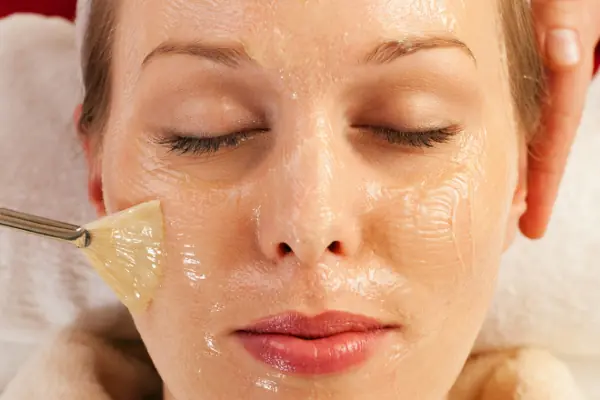
Retinoic acid temporarily turns the skin an intense yellow color, which is why the technique is also called yellow peeling.
This type of peeling is chemical because it is performed with a complex composition with an active ingredient called retinoic acid.
Its main advantage is the simultaneous effect on both the superficial and middle layers of the epidermis, which begin to actively regenerate and renew themselves after the procedure. In addition, this technique is considered to be as painless as possible, characterized by a rapid recovery period of the skin surface within 2 days after exfoliation.
Retinoic acid temporarily turns the skin an intense yellow color, which is why the technique is also called yellow peeling. The result of the effect of such acid on the skin is similar to the processes occurring in the epidermis upon contact with vitamin A, known for its powerful regenerating abilities, causing increased synthesis of collagen and elastin.
An important advantage is the preservation of skin cell hydration after such a procedure.
Existing types of procedure
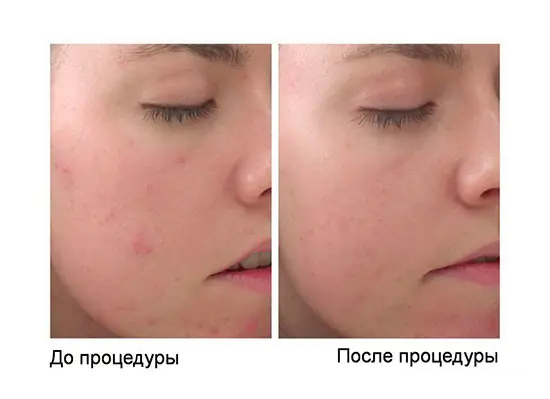
The classic look is characterized by the use of synthetic, concentrated retinoic acid, maximum exfoliation efficiency and is equivalent to a medium chemical peel.
Retinol peeling can be classic and gentle.
Classic look It is distinguished by the use of synthetic, concentrated retinoic acid, maximum exfoliation efficiency and is equal to the average chemical peeling. It is approved for use no more than 3 times a year, subject to preliminary ten-day preparation for the procedure, which involves the regular use of products that contain glycolic acid, which is necessary to soften the skin surface, open pores, and promote deeper penetration of the active components of the peeling composition.
Gentle peeling performed with a preparation based on natural retinol (vitamin A), which has a mild, superficial cleansing effect. It can be done every month. It does not require preliminary preparation of the skin.
Who is this method recommended for?
It is important to know what problems and skin defects the retinol peeling procedure will relieve in order to decide on the final choice of the most suitable exfoliation procedure.
Retinol peeling is recommended for:
- pronounced hyperpigmentation;
- age-related changes in the form of shallow wrinkles;
- skin photoaging;
- consequences of acne;
- heterogeneous relief of the skin surface.
Contraindications prohibiting the procedure
It is also necessary to take into account contraindications that prohibit such a procedure when:
- liver diseases;
- pregnancy and breastfeeding;
- taking medications that contain retinol and its derivatives;
- herpes virus in the acute stage;
- having a strong tan;
- any inflammatory processes on the skin of the face (viral, infectious);
- high skin sensitivity or individual intolerance to the components;
- renal failure;
- any oncological processes in the body;
- damage to the integrity of the skin in the form of wounds, scratches, insect bites;
- the presence of moles, papillomas, warts protruding above the surface of the skin.
Procedure
Before peeling, the skin must be tested for an allergic reaction, and then cleaned of any dirt and cosmetic residues that have accumulated during the day.
The technique involves going through the following stages:
- Pre-treatment of the skin with a solution containing salicylic and glycolic acids;
- Direct application of a preparation with retinolic acid, which is left on the skin surface from 15 minutes to several hours, depending on the existing defect and the selected concentration of the composition;
- Wash off the drug with a special acid-neutralizing solution that brings the pH of the skin to normal.
Do not hesitate to ask the specialist who will perform retinol peeling to show you documents about his specialized education, work experience, certificates received, as well as permission to engage in such activities in order to protect yourself from possible consequences caused by incompetence and lack of professional knowledge.
What are the advantages of retinol peeling?
This technique is in great demand among patients of cosmetology centers due to the presence of a number of advantages, including:
- safety for the skin associated with a gentle effect similar to the skin reaction upon contact with vitamin A;
- high effectiveness of drugs comparable to the effect of chemical median peeling;
- obtaining stable and long-lasting results with a minimum number of sessions performed (for example, 2 sessions of this peel are equal in effectiveness to 10 glycolic peeling procedures);
- a short recovery period, allowing the skin to recover within 2 days.
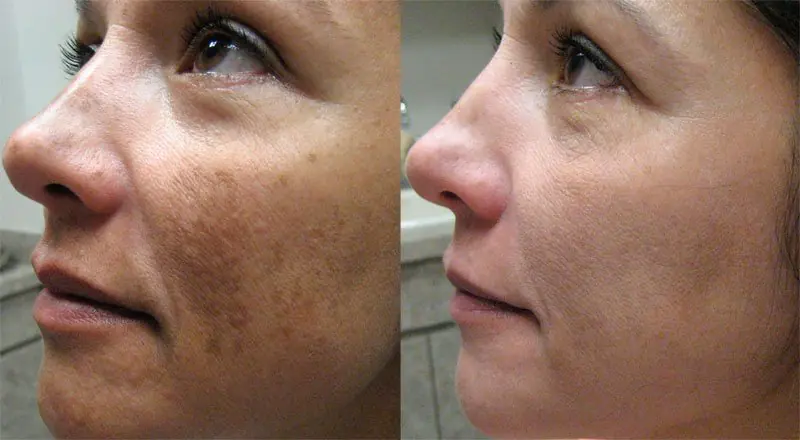
Persistent and long-lasting results
Possible complications
Most often, this type of peeling is well tolerated by the skin, but sometimes complications arise in the form of:
- Peeling and itching that disappear within 2 days;
- Swelling of the face, which goes away within a few days;
- Rashes on the surface of the skin that appear in patients with liver diseases, therefore, before the procedure, they are advised to use appropriate medications - hepatoprotectors;
- High sensitivity of the epidermis, which is associated with a particularly long recovery period, which is not typical for this technique;
- Exacerbation of herpes infection, successfully treated with antiviral drugs.
Taking care of your skin after the procedure
The specialist who carried out the technique must tell in detail about all the necessary measures for caring for the skin that has been treated, and recommend the best cosmetic compositions that will most help relieve inflammation and redness. There are rules prohibiting after such peeling:
- visit the beach, solarium, sauna and steam bath;
- perform strenuous physical exercise that causes sweating;
- be in direct sunlight without applying special protective equipment with a high SPF factor to the treated skin;
- apply decorative cosmetics;
- use scrubs and home peels.
How to do a retinol peel at home
Due to its gentle and gentle effect on the skin, retinol peeling can be performed independently by purchasing a well-known preparation called “Arcadia”, characterized by the presence of beta-carotene, ascorbic acid and vitamin E in its composition.
The technique for performing the procedure at home is almost similar to the technique performed in a salon.
The day before the session, be sure to test for sensitivity and allergic reactions.
- Before the procedure, clean the skin with a solution of glycolic acid, after which the drug chosen for peeling is applied to the skin using a brush.
- After keeping it on the surface of the skin for 30 minutes to 1 hour, remove the composition with a neutralizer. The presence of an orange tint on the skin is considered normal, as it is caused by the beta-carotene contained in the composition. After a few washes, the skin will return to its normal color.
- Post-peeling care involves the use of masks or creams with active anti-inflammatory, moisturizing and sun-protecting substances that help the skin recover faster.
Carefully study the expiration date of the purchased drug and the instructions for use included in the kit. Strictly follow all the requirements and recommendations of the manufacturer of the peeling composition you have chosen to avoid negative and serious consequences in the form of deep skin burns!
Do not forget that the effectiveness of the technique is influenced by the initial condition of the skin, so when the first signs of withering or other defects appear, do not delay visiting a cosmetologist. In this case, the procedure will be as effective and efficient as possible!
Video: Review of retinol peeling based on personal experience
Yellow peeling, which in cosmetology is called retinoic peeling, is a special procedure. It can replace modern creams, masks and other expensive products that help preserve youth for a long time. The article presents real reviews about retinoic peeling, photos before and after the procedure, as well as the stages of its implementation. This information will definitely be useful to modern girls and women who want to look better.
The essence and types of the procedure
Retinoic peeling is a procedure aimed at removing excess skin cells using special products. Today there are three types of peeling:
- Deep. A serious procedure in which the drug affects both living and dead cells.
- Average. The components of the drug penetrate deep into the skin.
- Surface. Eliminates dead parts of cells.
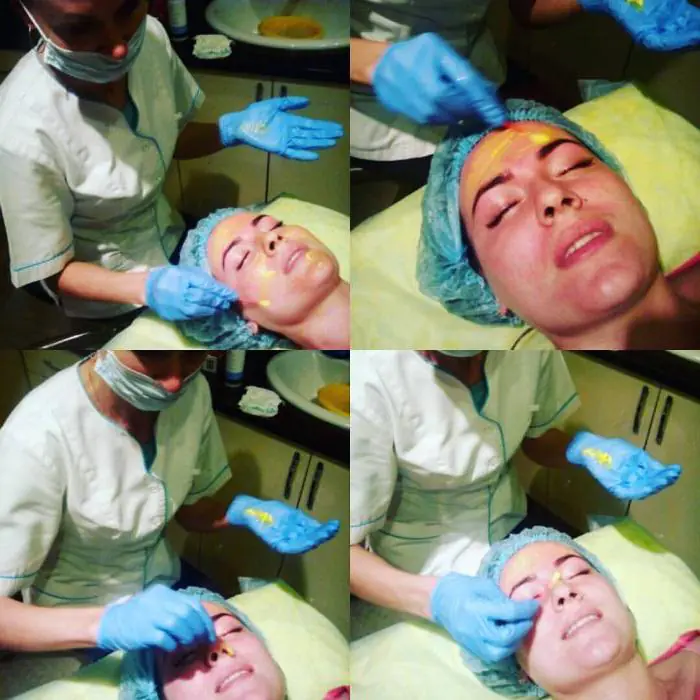
Peeling is called yellow, because after applying the composition to the surface of the facial skin, it acquires a yellowish tint. There is no need to be afraid of such an effect, because it is only a temporary phenomenon. The procedure is called retinol or retinoic peeling in connection with the main active component of the product - retinoic acid.
Experienced cosmetologists often call peeling a weekend procedure. It received this name due to the fact that patients will need exactly two days to recover. Experts strongly recommend going for a session on Friday so that by Monday your skin will be completely back to normal.
Expected Result
Most often, reviews from cosmetologists about retinoic peeling indicate that after the procedure the patient’s face looks much better. Thanks to the retinoids included in the composition, the following changes occur:
- wrinkles become less noticeable;
- blood circulation improves;
- the skin is cleansed of bacteria;
- the humidity level is normalized;
- a healthy glow appears.
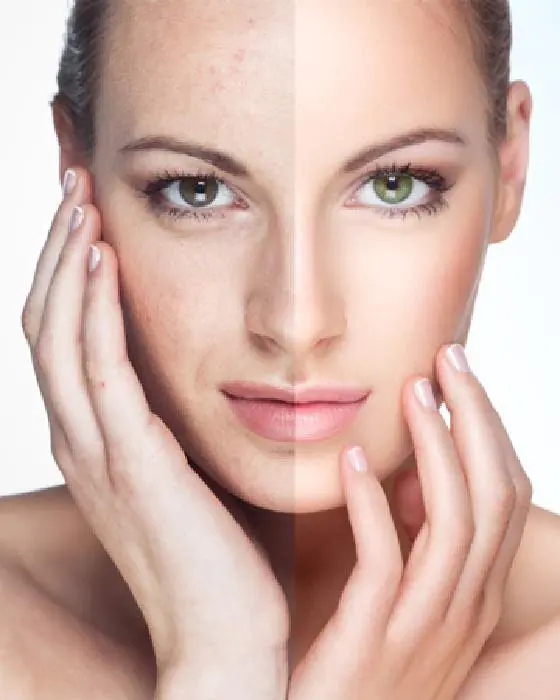
You can achieve these results quite easily, because a couple of sessions will be enough for this. The break between them should be exactly one and a half months. It is worth noting that the final result directly depends on the initial condition and characteristics of the skin.
The peeling contains various acids, each of which has its own unique properties:
- phytic acid is designed to fight emerging inflammatory processes;
- Koyaeva is able to destroy dead cells and reduce melanin levels;
- ascorbic acid (vitamin C) helps slow down the aging of the skin;
- azelaic acid perfectly regulates the functioning of the sebaceous glands, eliminates age spots and acne.
Who needs peeling?
The procedure is intended for those with mature skin. It is for this reason that older women most often leave reviews about retinoic peeling. Photos before and after the session make it clear that the procedure is truly effective and worthy of attention.
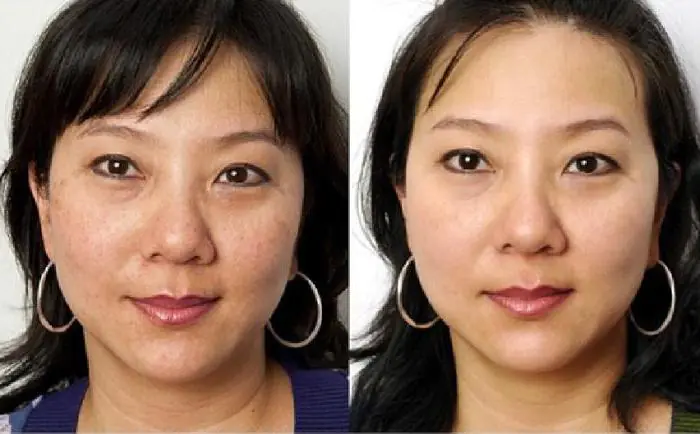
As a rule, patients aged 35-50 years turn to peeling. For younger women, the procedure will be useful in the following cases:
- overly rich and bright pigmentation;
- many pimples and blackheads;
- too strong activity of the sebaceous glands;
- pronounced acne scars;
- first destructive skin changes;
- skin diseases.
Advantages
Due to the large number of advantages, people most often leave positive reviews about retinoic peeling. The before and after photos presented in the article are a good example of how incredible results can be achieved.
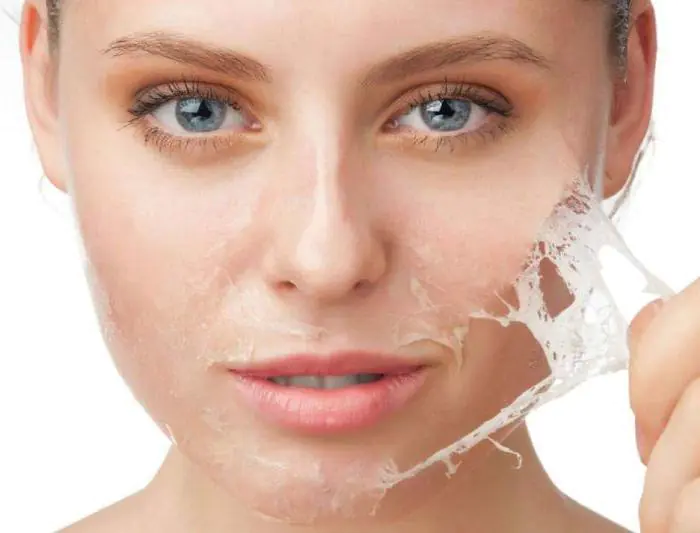
The main advantages of peeling include:
- Safety. In its component composition, retinoic acid is similar to vitamin A. Based on this, there is no need to worry about the human body’s reaction to it. The mixture also contains some other acids that can enhance the effect of retinoic acid, which is the active ingredient.
- Delicate impact. Yellow peeling is rightfully considered one of the most gentle, so there are no obstacles to achieving noticeable results.
- Efficiency. Most specialists begin rejuvenating the skin of their patients with this procedure. In some cases, the effect of a couple of sessions is equal to 10 procedures with glycolic acid. The resulting effect lasts quite a long time – up to 4 months.
- Fast recovery. The face after retinoic peeling, of course, will peel and turn red, but all these problems go away very quickly. For final restoration of the skin, no more than two days are needed.
Preparing for the session
Before skin rejuvenation, certain preparation for retinoic peeling is required. First of all, the specialist determines the type and condition of the skin, the tendency to allergies, as well as the presence of various ailments that may interfere with peeling. Immediately after this, the client is prescribed certain creams, which must be used for several weeks in a row. Most often, these products are based on glycolic acid. Thanks to them, the skin softens, which allows retinoids to easily penetrate to a greater depth. In the absence of proper preparation, the effect of the procedure may be several times less.
Retinol peeling requires avoiding tanning salons, using exfoliants, and long-term sun exposure. During the week before the procedure itself, you should remove yourself from all this so as not to damage the skin.
Carrying out the procedure
The first thing you need to do is cleanse your face of decorative cosmetics. Immediately after this, the skin is treated with a solution consisting of salicylic and glycolic acids. This helps remove dead cells. As soon as the solution begins to interact with the skin, it is cleansed. During this, the client may feel a slight burning sensation, which will go away in just 4-7 minutes.
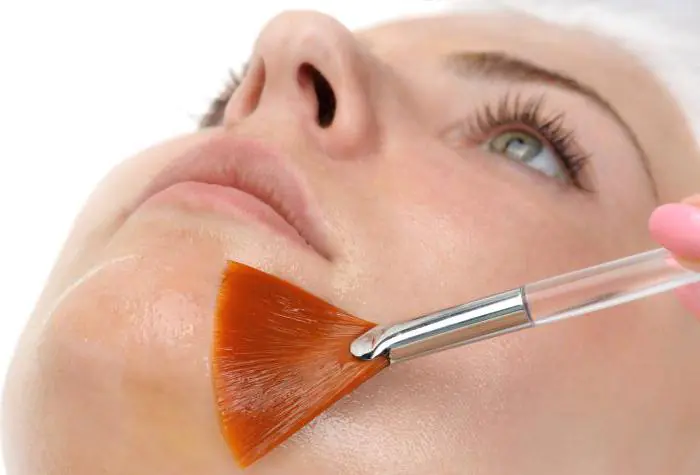
The next step is to apply the composition to the face. This mask can be kept on from 15 minutes to as long as 12 hours. The holding time is determined based on the desired result. After this, the product is thoroughly washed off under running water, and then a protective cream is applied to the skin and evenly distributed.
Consequences and contraindications
Contraindications and complications of retinoic peeling are of interest to all people who decide to undergo such a procedure for the first time. In this case, everything happens as usual: slight redness, itching, peeling and swelling appear. All this goes away quite quickly, so you will be able to enjoy the results very soon.
Complications after the procedure can only arise if it was performed with a low-quality composition or in the absence of proper preparation. Skin irritation or inflammation may occur. If they do not go away on their own for a long time, then you should definitely contact a specialist as soon as possible.
Peeling is not recommended for pregnant women or nursing mothers. In addition, cosmetologists prohibit performing the procedure for people who have:
- recent tanning;
- allergic reaction to vitamin C;
- active herpes;
- damage to the skin to which the composition must be applied;
- severe illness;
- individual intolerance to certain components.
Such people can replace the retinoic procedure with laser or ultrasound peeling. They also have the opportunity to turn to diamond microdermabrasion.
Skin care after peeling
The rehabilitation period does not last that long, but during this time it is necessary to take proper care after retinoic peeling. As you know, during recovery you feel severe dryness and tightness of the skin. After some time, a crust appears on the surface of the face, which under no circumstances should be removed. After a few hours it will go away on its own; if it is disturbed, complications may arise. Many reviews about retinoic peeling (photos before and after are below) say that when the crust is peeled off, scars, pimples, and age spots appear, which are not as easy to get rid of as it seems at first glance. Therefore, women who have already dealt with a similar problem are strongly recommended not to touch this layer.
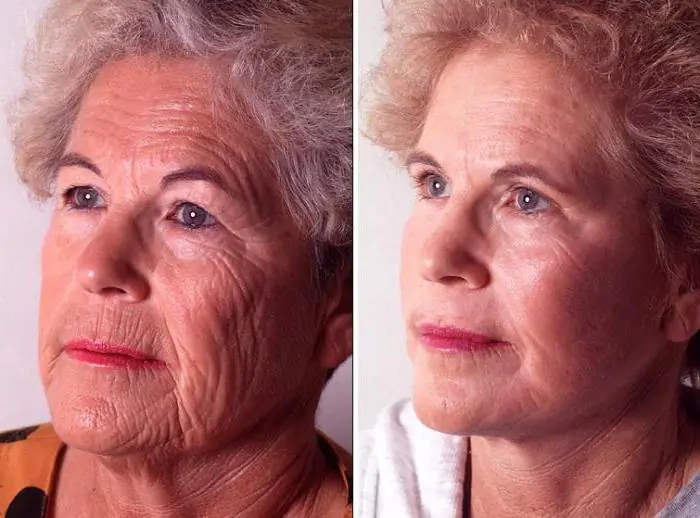
During rehabilitation, it is necessary to regularly use special means. They are prescribed by the specialist who performed the procedure, because he knows all the characteristics of his patients’ skin, and can also determine which products will help restore and not worsen the condition of the skin. When going for a walk under the scorching sun, you need to wear a classic wide-brimmed hat that will cover your face from the direct rays of the sun. In addition, you should first apply sunscreen to your face, thereby protecting yourself from the adverse effects of ultraviolet rays, which pose a particular danger during recovery.
Retinoic peeling itself is a safe procedure. In isolated cases, after a session, patients experience increased acne, which can only be treated by an experienced specialist. This side effect doesn't just happen. The main reasons are neglect of personal hygiene or contraindications. Therefore, in order to protect yourself from such consequences, you need to properly care for your facial skin not only after each procedure, but also use regular moisturizing and cleansing creams, lotions and other cosmetics daily.
Cost of the procedure
For people interested in skin rejuvenation, the price of retinoic peeling becomes relevant. Today, specialists in various salons perform the procedure for only 4-6 thousand rubles per session. For those with normal skin, for which two sessions are enough, paying for peeling will not be difficult. But those who require a course of treatment consisting of 4 procedures will have to spend a considerable amount of money.
The price of retinoic peeling is acceptable to many clients. For this money they get an incredible effect that they cannot achieve on their own.
Peeling with retinoic ointment at home
Conventional drugs containing retinoic acid are freely sold in pharmacies. You can buy them without a prescription. That is, buying a special ointment and using it at home will not be difficult.
The recipe for retinoic peeling at home is quite simple. To carry out the procedure yourself, you need to stock up on the following components:
- moisturizing cream;
- retinoic ointment;
- a tablespoon of water;
- glycolic cream;
- teaspoon of soda.
Many people are interested in how to do retinoic peeling at home, because this procedure will be several times cheaper than in a salon. In fact, there is nothing complicated about it. It is performed in several steps:
- cleansing the face of decorative cosmetics and wiping with a paper towel;
- applying and evenly distributing cream with glycolic acid over the surface of the face;
- skin treatment with a retinoic agent;
- applying a neutralizing mixture consisting of soda and water (45 minutes after the ointment);
- after 7 hours, rinse off the composition with warm water;
- moisturize the skin with regular cream.
As mentioned above, a slight burning sensation may be felt on the skin during the procedure. There is no cause for concern, since such a reaction only means that the composition reacts with the skin and the beginning of the process of cleansing and rejuvenation.
Immediately after the session, peeling begins. When performing peeling at home, it can last a little more than two days, but no more than a week. Under no circumstances should you manually assist natural exfoliation. This nuance must be taken into account, as there is a risk of damaging the skin. The best way to combat peeling during this period is frequent moisturizing with special products.
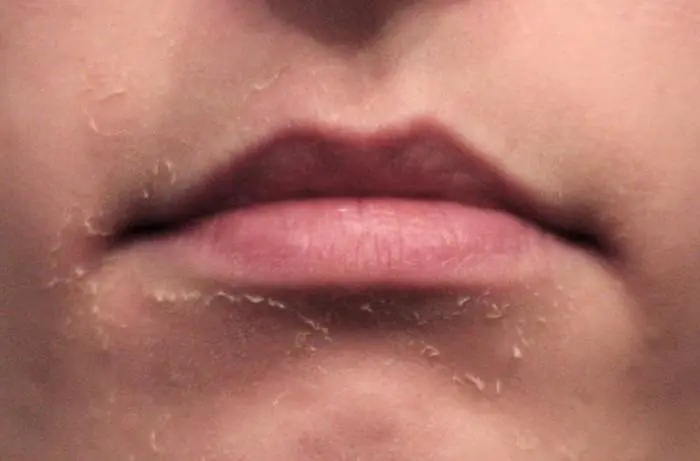
In the first days after peeling, redness will appear. They can only last a day or two. The skin will completely heal and recover within a week after the session.
You can secure a long-lasting effect by repeating the cleansing three times. That is, it is necessary to carry out the procedure once every three weeks, and then repeat the procedure again after six months.
Reviews
The opinion of patients regarding retinoic (yellow) peeling most often boils down to the fact that it is as effective and painless as possible. Many women who decide to undergo the procedure like to conduct various experiments with their skin without fear of an unpleasant result. After the peeling, they experienced only enthusiastic emotions, since they simply did not expect such an amazing effect.
Despite the cost of the session, which may seem high to some people, patients do not mind paying that kind of money for a peeling that will lift their spirits for a long time. Due to the fact that the procedure copes with several problems simultaneously, women are happy to turn to it and do not regret it in the future.
It is almost impossible to encounter negative reviews about it, since everyone is happy with the result obtained and has nothing against the means used to achieve it. Only a small part of women indicate some negative aspects in their reviews. The most common of these is a burning sensation felt during cleansing. At the same time, some people are unhappy that after the procedure they have to refrain from direct sunlight, which is quite difficult to do in the summer season.



